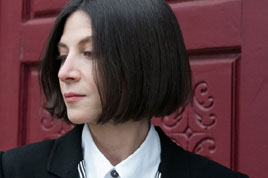Flawed, Fascinating Follow-Up To Beloved, Best-Selling Debut
by Jennifer Egan, The New York Observer, October 28, 2002
Like two other youngish authors, Jeffrey Eugenides and Jonathan Franzen, who recently tossedmassivevolumes onto the literary playing field after remaining largely silent since the early 90's, Donna Tartt has her own big cleats to fill. The Secret History, published in 1992, was an international sensation: a sprawling neo-Gothic extravaganza that managed to be brainy, literary and impossible to put down. It's the only book I've ever been seriously tempted to read while driving.
So it was with anticipation verging on lust that I opened Ms. Tartt's new novel, The Little Friend, a sprawling Southern Gothic tale about a 12-year-old girl trying to solve her older brother's murder. The results are paradoxical: Though The Little Friend ratifies and even amplifies the range of Ms. Tartt's abilities; though it takes place in a fictional world that's far more complex than the cloistered confines of the small private college where The Secret History is set; and though it has emotional and sociopolitical dimensions that were completely absent from the earlier book, it's finally less satisfying.
The novel presents itself as a murder mystery: 9-year-old Robin Cleve Dusfresnes is found hanging from a tree in his yard in small-town Alexandria, Miss., on Mother's Day. The murder apparently happened in the presence of his two younger sisters, Allison, 4, and Harriet, 6 months, who were on the porch at the time. After describing the day of the murder in riveting detail ("The air smelled fresh and tight, like rain"), Ms. Tartt rejoins the family 12 years later, when we find Robin's mother still half-comatose with grief, rarely leaving her bedroom. Allison and Harriet, now 16 and 12, are being raised mostly by their beloved black housekeeper, along with their maternal grandmother and three quirky great-aunts.
In passages evocative of Truman Capote's Other Voices, Other Rooms, Ms. Tartt conjures up a sultry atmosphere of extravagant Southern decay. "The night air was warm, and the moth-pale gardenia blossoms by the porch had a rich, warm, boozy smell," she writes. In this moribund milieu, dead Robin remains a vital part of his family's collective imagination. "His old aunts recalled mountains of trivia: toys he'd had, clothes he'd worn, teachers he'd liked or hated, games he'd played .... Some of this was accurate; some of it was not ... but when the Cleves chose to agree on some subjective matter it became—automatically and quite irrevocably—the truth, without any of them being aware of the collective alchemy which had made it so." But the family's myth-making apparatus is helpless to impose structure or meaning on Robin's unsolved murder. That job falls to Robin's youngest sister, Harriet, the sort of no-nonsense young female who's often described (though not by Ms. Tartt) as a spitfire. The Little Friend is the story of Harriet's compulsion to create a narrative, true or not, that can contain the vast mystery of her brother's death. It's also, in some loose sense, the literary artifact of her efforts.
Harriet's wish to avenge Robin's murder (which neither she nor her sister can remember) leads her immediately and rather arbitrarily to a suspect: Danny Ratliff, a onetime classmate of her brother's and now a member of Alexandria's demimonde. Recently released from prison, Danny is one of several scions of a poor and notoriously troubled family, and is presently helping his older brother make and sell (as well as consume, in increasing quantities) crystal methamphetamine. Harriet's pursuit of Danny and her attempts to punish him, carried out with the help of her admirer and sidekick, a boy named Hely, entangle her with the Ratliff clan, whose other members include an evangelical preacher with an interest in snake-handling, a retarded boy, and a long-suffering and marvelously rendered grandmother.
The sections describing the Ratliffs are some of the novel's strongest—far more engrossing than the sometimes tedious Hardy Boy machinations of Harriet and Hely. Ms. Tartt's descriptions of the ratcheting paranoia between the two crank-addled brothers are worthy of Robert Stone. Of Danny's older brother, Farish, she writes, "Sometimes he made sly insinuations, or got all crafty and confidential, pretending to let Danny in on nonexistent secrets; other times he sat back in his chair like he'd figured something out and—with a great big smile on his face—said, 'You son of a bitch. You son of a bitch.' ... [Danny] endured Farish's accusations ... answering slowly and with care, all politeness, nothing fancy, no sudden movements, the psychological equivalent of exiting his vehicle with his hands above his head." Later, when drug use has rendered both virtually psychotic, Ms. Tartt writes, "Sleep ceased to be sleep when you never had any; it rolled in at the last and crushed you senseless, a high, black wall that was more like death."
Harriet's pursuit of Danny plays directly into the brothers' paranoia, with disastrous results. In this sense, The Little Friend is the story of two families of opposing social ranks whose destinies become linked through a spate of blind, childish conviction. A thematically linked subplot concerns the relationship between Harriet's family and two devoted black servants, and contains some of the novel's most wrenching and socially conscious moments. Yet as the question of Robin's death recedes further into irrelevance, the reader can't help but feel cheated; The Little Friend has the feel of a shaggy dog story, a series of twists and turns and lateral moves that gets us further from—not closer to—the destination we've been so eagerly awaiting.
Some of this is due to the writing, which ranges from inspired and precise to blandly familiar. This is a book in which silence is deafening and hearts sink, over and over again. Ms. Tartt also has a habit of lavishing meticulous detail indiscriminately, rather than using it as a way of distinguishing important moments from incidental ones. A description of Harriet and Hely lugging a wagon from under a house to a railroad overpass lasts eight pages; at another point, Ms. Tartt tells us that Hely has drunk five Coca-Colas and then, parenthetically, specifies when and where he drank them. It's more than we need to know, and at times the pileup of qualifiers and digressions taxes the reader's attention.
There are disappointing books that make you lose faith in a writer. The Little Friend had the opposite effect on me; though it's an uneven performance, the novel displays such a big talent—for dialogue, for description, for quiet personal moments and broad, ambitious tableaux—that I find myself even more convinced than before that Donna Tartt is the real thing.
Jennifer Egan is the author of the novel, Look at Me and several other books..
+ + + Comments + + +



